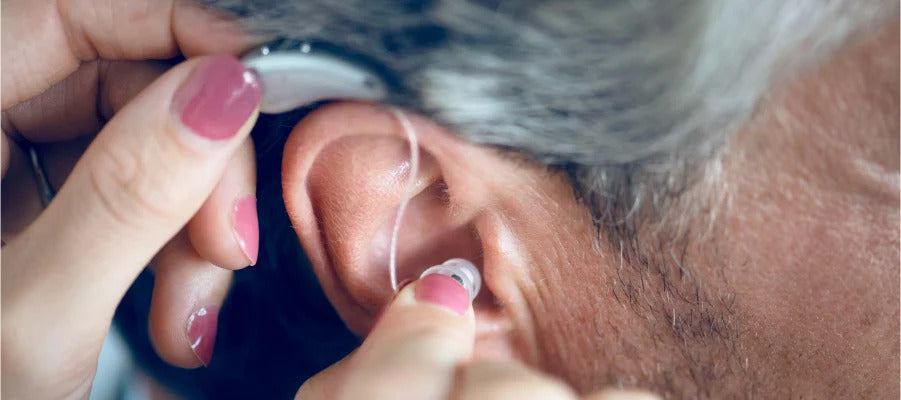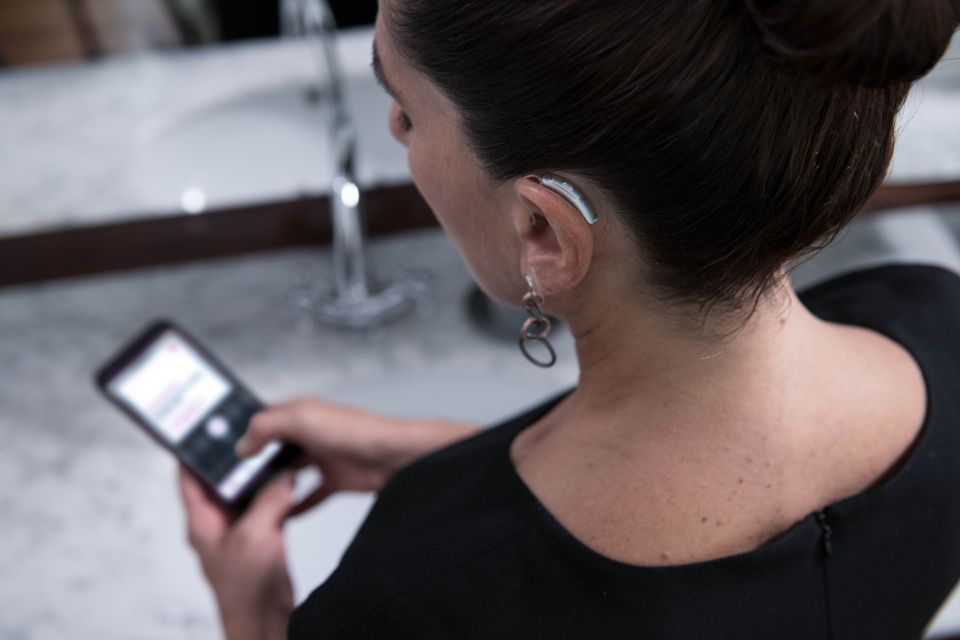BTE hearing aids, or behind-the-ear hearing aids, have always been one of the most popular choices for hearing solutions. They are powerful, versatile, and comfortable, providing strong amplification and ease of maintenance. BTE devices can cater to a wide range of hearing needs. So what makes them a top pick, and how to choose the right one? This guide is going to explore everything about BTE hearing aids. Just read on!
🚀 Navigate This Post
- ➤ Part 1: What Does BTE Mean in Hearing Aids?
- ➤ Part 2: BTE Hearing Aids Price — Are They Affordable?
- ➤ Part 3: Why Wear BTE Hearing Aids? — Pros & Ideal Users
- ➤ Part 4: Best BTE Hearing Aids — How to Choose the Right One?
- ➤ Part 5: Mini BTE Hearing Aids — Smaller Size, Same Power?
- ➤ Part 6: BTE vs RIC Hearing Aids — Which One is Right for You?
- ➤ Part 7: How to Clean and Care for BTE Hearing Aids?
- ➤ FAQs
You may also be interested in:
- [New] Best Affordable Hearing Aids with Bluetooth in 2025
- Best Rechargeable Bluetooth Hearing Aids: Worth It vs. Traditional?
- Top 5 Features to Consider When Buying Best Bluetooth Hearing Aids
- 7 Great Tips for First Time Hearing Aid Users
Part 1: What Does BTE Mean in Hearing Aids?
BTE stands for “behind-the-ear.” These devices house a receiver, a microphone, and a battery in a small case, resting comfortably behind the ear. Meanwhile, a clear tube connects the device to an earmold or dome inside the ear canal.

BTE hearing aids are relatively larger than other hearing aids, but they offer superior power and durability. As BTEs continue to evolve, there are mini BTE and BTE rechargeable hearing aids on the market. They are well known for blending performance with style and convenience.
As one of the most common hearing aids, BTEs suit users with mild to profound hearing loss and are easier to handle for those with dexterity challenges.
Part 2: BTE Hearing Aids Price — Are They Affordable?
According to NCOA’s consumer report, the pricing of BTE hearing aids can vary, starting at around $300–$1,000 per pair, while prescription BTEs can cost upwards of $3,000 per pair. These prices are subject to brand, features, and technology level.
While basic models are more affordable and often available over-the-counter (OTC), they might be limited in features. Premium models often come with advanced features such as Bluetooth streaming, rechargeable batteries, AI noise filtering, etc.

Meanwhile, high-end products include the cost of fitting, adjustments, and ongoing support from a hearing care professional. These services also increase the overall price. But BTE models can often provide better value due to their long lifespan and power.
Today, BTE hearing aids are typically less expensive via OTC than prescription models. But they may not offer the same level of customization or support. If you are shopping on a budget, OTC hearing aids can be a good option.
Part 3: Why Wear BTE Hearing Aids? — Pros & Ideal Users
With features like versatility, power, and user-friendly design, BTE hearing aids are strong options. They offer practical advantages that make daily use more convenient and effective.
Here are the key benefits of BTE hearing aids:
- Comfortable wear: Since BTEs don’t sit deep in the ear canal, many users find them more breathable and less intrusive.
- Rechargeable options: Available in both disposable and rechargeable battery formats. With evolving designs, BTE rechargeable hearing aids are quite common today.
- Bluetooth connectivity: Some of the best OTC hearing aids can pair wirelessly with smartphones, TVs, and tablets for enhanced usability.
- Longer battery life: BTE models often accommodate bigger batteries, which means they can last longer between charges.
- Powerful amplification: BTEs are suitable for those with moderate to profound hearing loss. They can house stronger amplifiers, providing the necessary gain for significant hearing loss.
- Easier maintenance: Only the earmold or dome contacts the ear canal, reducing moisture and wax issues.
- Fewer feedback problems: With the microphone and receiver separated by design, users experience fewer whistling or feedback issues.
- Open-fitting style: The thin tube design allows air flow in the canal, reducing the “plugged ear” sensation.

Compared to ITE (In-the-Ear), BTE hearing aids offer more power and battery life. ITEs are more discreet, but they can be harder to clean and handle for those with limited dexterity.
Compared to RIC (Receiver-in-Canal), BTEs are more durable and better for severe hearing loss. RICs provide a more natural sound. They are much smaller and more discreet.
Overall, BTE hearing aids remain a strong option for users such as children, older adults, and anyone seeking a reliable, high-performance hearing solution.

Diamond X1 - Best Hearing Aids with Bluetooth
Newcomer Price
$249.99 $309.99
- ✔ Adaptive sound modes for clear hearing.
- ✔ Bluetooth for calls & streaming.
- ✔ App-controlled, customizable adjustments.
- ✔ Rechargeable & fast charging.
- ✔ Ideal for mild to moderate hearing loss.
Part 4: Best BTE Hearing Aids — How to Choose the Right One?
Now you should have a solid background knowledge of BTE. Choosing the best BTE hearing aids is not about picking the most popular brand. It’s about matching your hearing needs, lifestyle, and budget. Here’s how to make a smart choice.
1. Before You Buy
Get a medical checkup: Visit your healthcare professional to rule out causes of hearing loss, such as impacted earwax or infections. Hearing aids won’t help if these problems can be resolved medically.
Ask for a referral to an audiologist: An audiologist can perform a full hearing test, recommend suitable devices, adjust the settings to match your hearing profile, and provide long-term support.
2. What to Look For in a BTE Hearing Aid
There are some advanced features you may want. For instance, Bluetooth for streaming calls and media, rechargeable batteries, noise reduction, etc. They can enhance daily life significantly. Meanwhile, choose a model that can be reprogrammed or upgraded in case your hearing worsens, so you don’t need to replace it frequently.
3. Ask About the Trial Period
Most hearing aids come with a 30–60 day trial. Make sure to get all trial terms in writing and confirm if trial costs go toward the final price. You should also understand how much it is refundable if you return it.

4. Check the Warranty & Aftercare
Ensure your BTE hearing aids come with a warranty covering both parts and services. Also, ask if follow-up visits, cleanings, or remote adjustments are included in the price. Some audiologists offer the option to extend the warranty, and see if you need it for peace of mind.
5. Plan Your Budget
You can check whether your private insurance covers hearing aids. If you are a veteran, you may be eligible for free hearing aids through the VA. Some nonprofit organizations or local civic groups also offer financial assistance or low-cost devices.
Part 5: Mini BTE Hearing Aids — Smaller Size, Same Power?
Mini BTE hearing aids are less visible than full-size BTEs, yet can retain much of the same power. They often include modern features like directional microphones, feedback suppression, and even rechargeability.

Equipped with thin tubing and smaller casings, Mini BTE hearing aids look more discreet and lightweight behind the ear. For those who are keen on Invisible hearing aids, Mini BTEs can be an ideal choice, which strikes a balance between form and function.
However, Mini BTE hearing aids are more suitable for mild to moderate hearing loss; they may not deliver the same amplification level needed for profound loss.
Part 6: BTE vs RIC Hearing Aids — Which One is Right for You?
BTE vs RIC hearing aids: what’s the difference, and which one to choose? Check out this brief comparison between BTE and RIC hearing aids to learn more.
| Feature | BTE (Behind-the-Ear) | RIC (Receiver-in-Canal) |
|---|---|---|
| Comfort | Slightly bulkier; rests behind the ear with a visible tube | Smaller and lighter; more discreet and comfortable for many |
| Sound Quality | Clear and powerful, but it may sound less natural | Typically offers a more natural sound due to the receiver in the canal |
| Maintenance | Easier to clean; less prone to wax and moisture buildup | The receiver is in the ear canal, requiring more frequent cleaning |
| Hearing Loss Level | Suitable for moderate to profound hearing loss | Ideal for mild to moderate hearing loss |
Overall, you can choose RIC hearing aids if you have mild to moderate hearing loss and look for a discreet hearing solution. BTE hearing aids, on the other hand, offer strong amplification and low maintenance. They are a robust choice for those with higher hearing loss levels.
Part 7: How to Clean and Care for BTE Hearing Aids?
Regular cleaning and care can help keep BTE hearing aids working properly and extend their lifespan. Here’s how to clean hearing aids in practice.
Step 1: Detach the earmold and tubing from the hearing aid.
Step 2: Clean the tubing with a pipe cleaner; soak the earmold in warm, soapy water and dry thoroughly.
Step 3: Brush away debris from the microphone openings and wipe the device gently.
Step 4: Use a wax loop or pick to carefully clean out any remaining wax in hard-to-reach areas.
Step 5: Dry, reassemble, and test to ensure the hearing aid functions properly.
You can also explore recommended hearing aids cleaning tools for the best results.

In addition, make sure to store your hearing aids in a drying kit or dehumidifier every night to remove excess moisture. Do not use harsh chemicals or excessive water to clean your hearing aids. For deeper cleaning or tube replacements, consult your hearing care professional for regular maintenance and support.




コメントを書く
全てのコメントは、掲載前にモデレートされます
このサイトはhCaptchaによって保護されており、hCaptchaプライバシーポリシーおよび利用規約が適用されます。